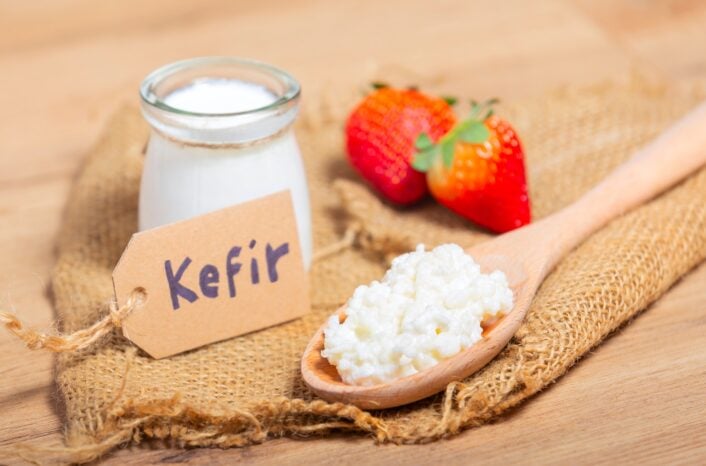Disclaimer: This article is for informational purposes only and is not intended to diagnose any conditions. LifeDNA does not provide diagnostic services for any conditions mentioned in this or any other article.
What if a tiny organism could help improve your gut health, strengthen your immune system, and even protect your teeth? Lactobacillus rhamnosus (L. rhamnosus), currently officially called Lacticaseibacillus rhamnosus, is a good bacteria that lives in many parts of the body, including the gut and vagina. It moves through your body, starting from your mouth traveling through your digestive system and out through the colon. In women, it also reaches the vaginal area, where it helps keep it healthy.
Understanding the benefits of Lactobacillus rhamnosus is important because it helps improve gut health, support the immune system, which are key for overall well-being. Knowing its purpose can help us use it effectively through supplements or probiotic-rich foods to support our health.
What is Lacticaseibacillus rhamnosus
Lactobacillus rhamnosus has a unique ability to adapt to different environments because of specific genes it carries. Its genome (the complete set of genes) contains over 4,700 genes in total, with around 2,100 being core genes that are essential for its basic survival and is also known as a commercial probiotics preparation Culturelle. The rest of the genes help it to do special jobs, like breaking down sugars, producing helpful substances, and defending itself from harmful bacteria.
- rhamnosus is able to survive both acidic and basic conditions in your body, and it can stick to the walls of your intestines, allowing it to thrive and offer lasting benefits. When the overall balance of bacteria in your gut,gets disrupted, it may lead to digestive issues and other health problems. But L. rhamnosus helps restore that balance by improving digestion, easing symptoms like Irritable Bowel Syndrome and diarrhea, and can even help to protect your teeth from decay.
So, how can you get these benefits? Lactobacillus rhamnosus is available as a supplement and is often added to foods like yogurt, cheese, and milk to boost their probiotic content. Adding it into your diet is an easy and effective way to support your gut health every day.
Functions of Lacticaseibacillus rhamnosus
L.rhamnosus supports overall health in many ways, from protecting the gut and vaginal health to reducing inflammation and boosting the immune system. Here’s how it helps:
- Creates a Strong Barrier
L.rhamnosus forms a protective shield in your body. It produces a biofilm that acts as a barrier, stopping harmful microbes from passing through the gut lining and causing infection. This biofilm provides a safe space for beneficial microbes to thrive. - Repairs Damaged Barriers
When the gut barrier is damaged, L.rhamnosus helps repair it. It strengthens the connections between cells that helps prevent leaks that could let harmful substances enter the bloodstream. - Supports the Microbial Community
This bacteria plays a key role in supporting the healthy balance of microbes in the gut. It activates beneficial microbes through chemical signals, helping maintain a balanced and healthy microbiome. - Fights Off Harmful Pathogens
L.rhamnosus helps protect the body by fighting harmful bacteria. For example, some strains produce proteins that stop the growth of pathogens like Salmonella, helping prevent infections and keeping the microbial community in balance. - Reduces Inflammation
This species helps reduce inflammation in the body. It may influence the immune system to lower inflammation in conditions like diarrhea and vaginal infections. L.rhamnosus also boosts certain immune cells that help fight infections, with research suggesting benefits for respiratory tract infections and skin conditions like eczema. - Prevents Pathogens from Sticking
L.rhamnosus produces biosurfactants that disrupt the biofilms of harmful pathogens like E. coli, making it harder for them to stick to and infect cells in the digestive and vaginal tracts. This helps maintain vaginal health and prevents infections.
Benefits of Lacticaseibacillus rhamnosus
L.rhamnosus provides various health benefits, improving both gut and overall well-being:
- Prevents and Treats Diarrhea
By creating a protective barrier in the gut and promoting a balanced microbiome, this bacterium helps prevent the harmful bacteria that cause diarrhea. Its ability to restore gut health and support digestion is key to treating various types of diarrhea, such as antibiotic-associated diarrhea and traveler’s diarrhea. - Relieves IBS Symptoms
The bacterium helps maintain a healthy microbial balance in the gut, addressing the underlying imbalance of harmful and beneficial bacteria that often leads to IBS symptoms. By strengthening the gut barrier, it reduces the gut’s sensitivity and inflammation, providing relief from common IBS symptoms like bloating and abdominal pain. - Aids Gut Health
It plays a vital role in maintaining gut health by creating a favorable environment for good bacteria to thrive. Its production of lactic acid prevents the growth of harmful bacteria and promotes the growth of beneficial microbes, while also nourishing the gut lining and supporting overall gut function. - Protects Against Cavities
The bacterium’s antimicrobial properties help reduce harmful bacteria in the mouth, which is crucial for preventing cavities. By disrupting the growth of decay-causing bacteria and supporting healthy oral flora, it helps maintain strong teeth and gums. - Prevents UTIs
By maintaining a healthy balance of bacteria in the urinary and vaginal tracts, it prevents the overgrowth of harmful bacteria like E. coli, which can lead to UTIs. Its protective role in balancing microbial communities in these areas helps reduce the risk of infections and promotes overall urinary tract health.
Scientific Studies on of Lacticaseibacillus rhamnosus
Lacticaseibacillus rhamnosus have unique benefits for health. Here’s a look at some of the scientific studies conducted on this beneficial bacterium.
Lacticaseibacillus rhamnosus GG and Its Benefits
L.rhamnosus GG is one of the most well-researched strains of L. rhamnosus. Isolated in 1983 by scientists Sherwood Gorbach and Barry Goldin, this strain is known for its excellent ability to bind to the mucus lining the gut. L. rhamnosus GG provides various health benefits, especially in supporting gut health and immune function. It is particularly popular for its effectiveness in treating and preventing diarrhea and boosting immune health. This strain has become a trusted probiotic due to its ability to improve digestion and support overall well-being.
A study looked at how Lacticaseibacillus rhamnosus GG behaves when in yogurt. The researchers found that the bacteria’s DNA stayed mostly the same during the yogurt-making process, with only one single sample showing a small genetic change. This was a deletion of a gene cluster important for helping the bacteria stick to mucus. Despite this, most of the bacteria kept their probiotic abilities. The study also tested how the bacteria worked in yogurt, comparing it to bacteria stored as frozen pellets. It found that L. rhamnosus GG in yogurt helped strengthen the intestinal barrier more than when it was stored frozen, suggesting that the yogurt environment might enhance its effects.
The study also found that L. rhamnosus GG stayed strong against stomach acid in both frozen and yogurt forms, but it was a bit less resistant to bile in yogurt. In terms of immune response, the bacteria helped control the release of certain immune proteins when combined with the yogurt starter culture, although the effect was less strong than that of the yogurt starter on its own. Overall, the study showed that L. rhamnosus GG is mostly stable in yogurt, and the yogurt matrix may even boost some of its beneficial effects, like improving gut health.
Side Effects of Lactobacillus Rhamnosus
When taking probiotics like Lactobacillus rhamnosus, some people may experience mild side effects as their body adjusts to the changes in the gut microbiota. These effects are typically temporary and subside as the body becomes accustomed to the new bacteria. Below are some common side effects and their explanations.
- Bloating
Bloating refers to a feeling of fullness or swelling in the abdomen, often due to trapped gas or an increase in the size of the stomach. When introduced into the gut, probiotics can cause an increase in gas production as they interact with existing gut bacteria, leading to bloating, especially in individuals with sensitive digestive systems. - Gas
Gas is the presence of air or other gases in the digestive tract, which can lead to burping, flatulence, or discomfort. Probiotics alter the microbial balance in the gut, resulting in the production of more gas as they break down food, particularly during the early stages of supplementation. - Stomach Rumbling or Gurgling
Stomach rumbling, or borborygmi, is the noise made by movement of gas and liquids through the intestines. As probiotics work to rebalance the gut microbiota, they can cause an increase in digestive activity, leading to rumbling sounds or gurgling in the stomach. This is usually temporary as the body adjusts. - Itching
This side effect may occur if the body is sensitive to the specific bacterial species or other ingredients in the probiotic supplement, sometimes indicating a mild allergic reaction. - Rash
A rash refers to a visible change in the skin, such as redness, swelling, or bumps. It may be a rare allergic response to the supplement or its ingredients. This usually goes away once the body adjusts or the supplement is discontinued.
References:
https://www.healthline.com/nutrition/lactobacillus-rhamnosus
https://www.gbif.org/species/165689797
https://internationalprobiotics.org/home/7-things-lacticaseibacillus-rhamnosus-is-good-for/
https://pubmed.ncbi.nlm.nih.gov/20573348/
https://www.cancer.gov/publications/dictionaries/cancer-terms/def/lactobacillus-rhamnosus-gg




